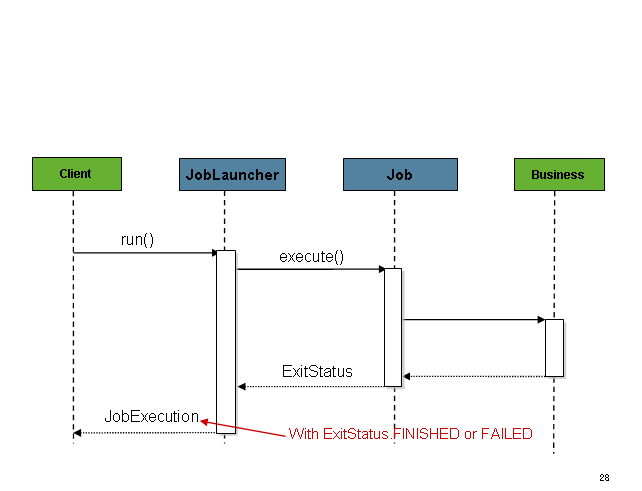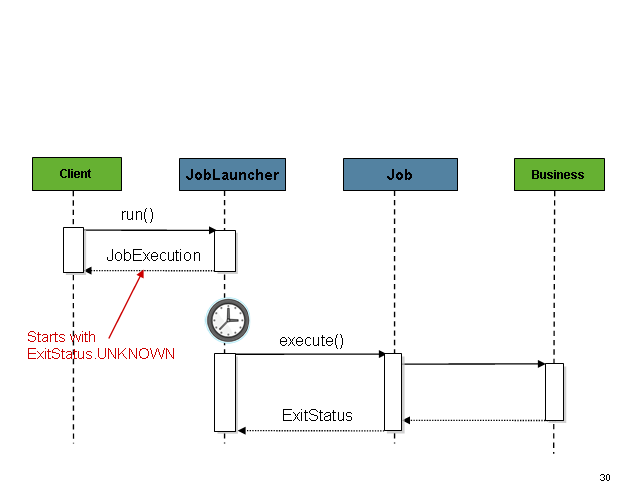在 Spring Batch(1)——数据批处理概念 文中介绍了批处理的概念以及Spring Batch相关的使用场景,后续将会陆续说明在代码层面如何使用。
引入
Spring batch的引入非常简单,只需要引入Spring Framework、Datasource以及Spring Batch。在Spring Boot体系下只需引入spring-boot-starter-batch 即可。他已经涵盖了以上所有内容。
Job配置
Job接口有多种多样的实现类,通常我们使用configuration类来构建获取一个Job:
@Bean
public Job footballJob() {
return this.jobBuilderFactory.get("footballJob") //Job名称
.start(playerLoad()) //Job Step
.next(gameLoad()) //Job Step
.next(playerSummarization()) //Job Step
.end()
.build();
}上面的代码定义了一个Job实例,并且在这个实例中包含了三个Step实例
重启(启动)配置
批处理的一个核心问题是需要定义重启(启动)时的一些行为。当指定的JobInstance被JobExecution执行时候即认为某个Job已经重启(启动)。理想状态下,所有的任务都应该可以从它们之前中断的位置启动,但是某些情况下这样做是无法实现的。开发人员可以关闭重启机制或认为每次启动都是新的JobInstance:
@Bean
public Job footballJob() {
return this.jobBuilderFactory.get("footballJob")
.preventRestart() //防止重启
...
.build();
}监听Job Execution
当任务执行完毕或开始执行时,需要执行一些处理工作。这个时候可以使用JobExecutionListener:
public interface JobExecutionListener {
void beforeJob(JobExecution jobExecution);
void afterJob(JobExecution jobExecution);
}添加方式:
@Bean
public Job footballJob() {
return this.jobBuilderFactory.get("footballJob")
.listener(sampleListener()) //JobExecutionListener的实现类
...
.build();
}需要注意的是afterJob方法无论批处理任务成功还是失败都会被执行,所以增加以下判断:
public void afterJob(JobExecution jobExecution){
if( jobExecution.getStatus() == BatchStatus.COMPLETED ){
//job success
}
else if(jobExecution.getStatus() == BatchStatus.FAILED){
//job failure
}
}除了直接实现接口还可以用 @BeforeJob 和 @AfterJob 注解。
Java配置
在Spring Batch 2.2.0版本之后(Spring 3.0+)支持纯Java配置。其核心是@EnableBatchProcessing注解和两个构造器。@EnableBatchProcessing的作用类似于Spring中的其他@Enable*,使用@EnableBatchProcessing之后会提供一个基本的配置用于执行批处理任务。对应的会有一系列StepScope实例被注入到Ioc容器中:JobRepository、JobLauncher、JobRegistry、PlatformTransactionManager、JobBuilderFactory以及StepBuilderFactory。
配置的核心接口是BatchConfigurer,默认情况下需要在容器中指定DataSource,该数据源用于JobRepository相关的表。开发的过程中可以使用自定义的BatchConfigurer实现来提供以上所有的Bean。通常情况下可以扩展重载DefaultBatchConfigurer类中的Getter方法用于实现部分自定义功能:
@Bean
public BatchConfigurer batchConfigurer() {
return new DefaultBatchConfigurer() {
@Override
public PlatformTransactionManager getTransactionManager() {
return new MyTransactionManager();
}
};
}使用了@EnableBatchProcessing之后开发人员可以使用以下的方法来配置一个Job:
@Configuration
@EnableBatchProcessing
@Import(DataSourceConfiguration.class)
public class AppConfig {
@Autowired
private JobBuilderFactory jobs;
@Autowired
private StepBuilderFactory steps;
@Bean
public Job job(@Qualifier("step1") Step step1, @Qualifier("step2") Step step2) {
return jobs.get("myJob").start(step1).next(step2).build();
}
@Bean
protected Step step1(ItemReader<Person> reader,
ItemProcessor<Person, Person> processor,
ItemWriter<Person> writer) {
return steps.get("step1")
.<Person, Person> chunk(10)
.reader(reader)
.processor(processor)
.writer(writer)
.build();
}
@Bean
protected Step step2(Tasklet tasklet) {
return steps.get("step2")
.tasklet(tasklet)
.build();
}
}JobRepository配置
一旦使用了@EnableBatchProcessing 注解,JobRepository即会被注入到IoCs容器中并自动使用容器中的DataSource。JobRepository用于处理批处理表的CURD,整个Spring Batch的运行都会使用到它。除了使用容器中默认的DataSoruce以及其他组件,还可以在BatchConfigurer中进行配置:
@Override
protected JobRepository createJobRepository() throws Exception {
JobRepositoryFactoryBean factory = new JobRepositoryFactoryBean();
factory.setDataSource(dataSource);
factory.setTransactionManager(transactionManager);
factory.setIsolationLevelForCreate("ISOLATION_SERIALIZABLE");
factory.setTablePrefix("BATCH_");
factory.setMaxVarCharLength(1000);
return factory.getObject();
}在代码中可以看到,设置JobRepository需要DataSource和TransactionManager,如果没有指定将会使用容器中的默认配置。
JobRepository的事物配置
默认情况下框架为JobRepository提供了默认PlatformTransactionManager事物管理。它用于确保批处理执行过程中的元数据正确的写入到指定数据源中。如果缺乏事物,那么框架产生元数据就无法和整个处理过程完全契合。
如下图,在BatchConfigurer中的setIsolationLevelForCreate方法中可以指定事物的隔离等级:
protected JobRepository createJobRepository() throws Exception {
JobRepositoryFactoryBean factory = new JobRepositoryFactoryBean();
factory.setDataSource(dataSource);
factory.setTransactionManager(transactionManager);
factory.setIsolationLevelForCreate("ISOLATION_REPEATABLE_READ");
return factory.getObject();
}setIsolationLevelForCreate方法支持2个值:ISOLATION_SERIALIZABLE、ISOLATION_REPEATABLE_READ,前者是默认配置,类似于@Transactional(isolation = Isolation.SERIALIZABLE),表示查询和写入都是一次事物,会对事物进行严格的锁定,当事物完成提交后才能进行其他的读写操作,容易死锁。后者是读事物开放,写事物锁定。任何时候都可以快速的读取数据,但是写入事物有严格的事物机制。当一个事物挂起某些记录时,其他写操作必须排队。
修改表名称
默认情况下,JobRepository管理的表都以*BATCH_*开头。需要时可以修改前缀:
// This would reside in your BatchConfigurer implementation
@Override
protected JobRepository createJobRepository() throws Exception {
JobRepositoryFactoryBean factory = new JobRepositoryFactoryBean();
factory.setDataSource(dataSource);
factory.setTransactionManager(transactionManager);
factory.setTablePrefix("SYSTEM.TEST_"); //修改前缀
return factory.getObject();
}内存级存储
Spring Batch支持将运行时的状态数据(元数据)仅保存在内存中。重载JobRepository不设置DataSource即可:
@Override
protected JobRepository createJobRepository() throws Exception {
MapJobRepositoryFactoryBean factory = new MapJobRepositoryFactoryBean();
factory.setTransactionManager(transactionManager);
return factory.getObject();
}需要注意的是,内存级存储无法满足分布式系统。
JobLauncher配置
启用了@EnableBatchProcessing之后JobLauncher会自动注入到容器中以供使用。此外可以自行进行配置:
@Override
protected JobLauncher createJobLauncher() throws Exception {
SimpleJobLauncher jobLauncher = new SimpleJobLauncher();
jobLauncher.setJobRepository(jobRepository);
jobLauncher.afterPropertiesSet();
return jobLauncher;
}JobLauncher唯一的必要依赖只有JobRepository。如下图,Job的执行通常是一个同步过程: 
可以通过修改TaskExecutor来指定Job的执行过程:
@Bean
public JobLauncher jobLauncher() {
SimpleJobLauncher jobLauncher = new SimpleJobLauncher();
jobLauncher.setJobRepository(jobRepository());
jobLauncher.setTaskExecutor(new SimpleAsyncTaskExecutor()); //转换为异步任务
jobLauncher.afterPropertiesSet();
return jobLauncher;
}这样执行过程变为:

运行一个Job
以一个Http为例:
@Controller
public class JobLauncherController {
@Autowired
JobLauncher jobLauncher;
@Autowired
Job job;
@RequestMapping("/jobLauncher.html")
public void handle() throws Exception{
jobLauncher.run(job, new JobParameters());
}
}单单是配置好Job是肯定无法执行的,还需要对Step进行配置。后面会陆续介绍。
本文转载自: https://my.oschina.net/chkui/blog/3069723





















 2300
2300











 被折叠的 条评论
为什么被折叠?
被折叠的 条评论
为什么被折叠?








